Kentucky Pesticide Safety Education Program

Questions?
Contact
Dr. Ric Bessin
Dept. of Entomology
University of Kentucky
859-257-7456
rbessin@uky.edu
Disease Management in the Interiorscape Environment
by Dr. Nicole Gautheir, Department of Plant Pathology, University of Kentucky
The occurrence of diseases on indoor landscape plants is typically a result of adverse environmental conditions combined with the presence of pathogens (fungi, water molds, bacteria, viruses or nematodes). Diseases are uncommon in the indoor landscape setting if it was established using disease-free plant material. It is critical to identify the causal agent or the type of disease that arises in the interior landscape in order to take appropriate corrective measures.
To manage plant diseases and disorders successfully, one must be able to:
- Recognize symptoms and signs that indicate the presence of a disease or disorder.
- Accurately identify the cause and type of problem (abiotic or pathogenic or both).
- Select the best method(s) for correcting conditions that contributed to the disease development.
[return]
The Disease Triangle
In order to manage plant health, it is helpful to understand which conditions influence disease development. The “disease triangle” illustrates the three primary factors that must be present for a disease to occur:
Pathogen: the abundance, aggressiveness, and other characteristics of the pathogen causing disease can influence disease development. Some pathogens are widespread and infect many types of plants; others are notpathogens are host-specific
Host Plant: the genetic susceptibility and general condition of the plant influence disease development. Healthy, stress-free plants are less susceptible to disease than weakened plants. Different species or cultivars of plants may be more or less susceptible to infection. Plant vigor can also affect disease severity; stressed plants often become increasingly susceptible to infection and disease.
Environment: certain environmental conditions which are favored by pathogens. These include temperature (moderate temperatures) and moisture (free water, humidity, and soil moisture). Factors such as light, density of plantings, location of plants, and climates/microclimates affect temperature and moisture.
The goal is to recognize and manipulate these primary factors to promote stress-free plants and to eliminate conditions favorable for disease development.
[return]
Managing Diseases
The disease triangle reminds us of the factors necessary for disease development. A susceptible host plant and a pathogen must be present, along with the proper environmental conditions in order for a disease to occur. Conditions that favor the development of pathogenic diseases can be avoided in the interior landscape setting. Overhead irrigation, splashing water, prolonged leaf wetness, high humidity, crowded blocks of similar plants, and propagation of infected stock are conditions that may be common in poorly managed interiorscapes.
Additionally, diseases in the interior landscape may manifest as a "secondary" disease after a plant has been stressed by adverse cultural or environmental conditions. Correcting the stress often prevents infection or reduces development of disease.
Introduction of plant pathogens by infected plant material is the most common source for plant disease in the interiorscape. The goal of nursery growers is to produce high-quality plants that are pathogen-free. These facilities often rely on fungicides to prevent the development of diseases. If fungicides are used after infection occurred, the fungicides suppress disease; they do not cure it. Thus suppressed infections may be introduced to interiorscapes and later develop into disease.
The use of fungicides in an interior landscape is not always possible due to the need for repeated treatments and the limited number of fungicides registered for use in interior landscapes. For example, a fungicide may be labeled for use on a plant(s) and/or for a pathogen, but often it is not labeled for use in an interior landscape setting. In these cases, it may be necessary to temporarily relocate the plant to a location that is on the label (such as outdoors or in a greenhouse) in order to make the treatment. By removing a plant from its interior landscape, the options for fungicide applications are expanded, although temporarily relocating plants may not always be practical.
Accurate diagnosis is critical for selecting appropriate corrective measures.
Fungicides are only effective in controlling specific pathogens listed on the label. Confirmation of the pathogen causing disease is important. Accurate diagnosis of plant pathogens may require laboratory analysis. Samples should be collected from symptomatic tissue that is representative of the particular problem. Larger samples, preferably whole plants, generally enable more accurate diagnoses. Otherwise, collect multiple leaves, stems, and roots from plants showing a range of symptoms. Remember that leaf symptoms may be the result of a stem or root problem. Always leave soil around roots so that soil can be analyzed. Diagnostic assistance can be obtained from your local Cooperative Extension Service.
Disease symptoms on foliage or stems are more likely to be noticed than root or crown symptoms. Rapid diagnosis and management can stop the spread to other plants. If plant damage is not severe and has been checked by your management procedure the plant may still be attractive enough to remain on site. When an infection becomes severe, the best alternative is removal of the plant and infested growing media.
[return]
Fungi
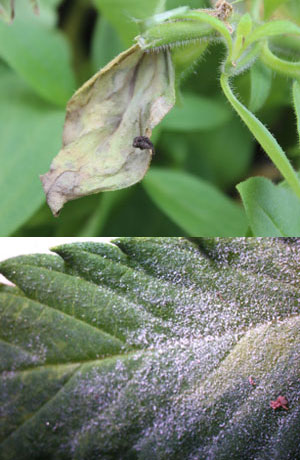
Management of fungal diseases should focus on prevention. Exclusion of the pathogen is the first step toward prevention. Environmental conditions such as moisture can be managed through increased air circulation and good drainage. This will help reduce infection and spread. Cultural practices such as sanitation help remove sources of fungi (e.g. infected leaves) from the site. Fungicides do not cure infected leaves and stems, but they can protect new tissue as plants grow. Fungal root rots cannot be managed with fungicides, and infected plants should be destroyed to avoid spread.
[return]
Water Molds
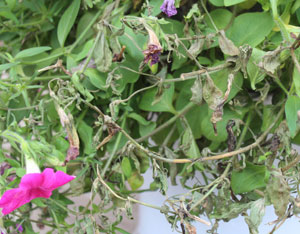
Water molds produce a spore stage that is adapted to spread by swimming in water. High soil moisture levels caused by overwatering, poorly drained media, or water standing in the bottom of the containers induce infection of roots by these water molds.Root damage caused by over fertilization, buildup of salts in the soil, chilling or freezing temperatures, or phytotoxicity increase susceptibility to root rots.
Management of water mold disease includes prevention. Exclusion of the pathogen, especially though contaminated soil and infested pots and tools, is the first step toward managing disease. Avoid environmental conditions that are favored by water molds, including excess soil moisture, and poor drainage. Proper soil drainage and proper irrigation, as well as managed fertilization and good sanitation practices help avoid and/or correct root rot diseases in general. Be aware of the changes in the physical structure of the rooting media. As media ages, it may settle and pack in the bottom of containers and hinder drainage. Diseased plants cannot be cured with fungicides; drenches may suppress disease in limited situations, but symptoms return once fungicide applications are terminated. Destruction of infected plants is recommended.
[return]
Bacteria
Plant diseases caused by bacteria are less common than fungal diseases, but they can still cause economic losses.
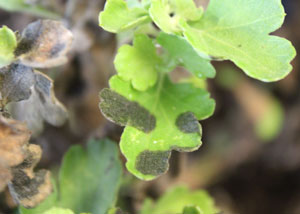
Management of bacterial diseases begins with prompt removal of infected plant parts. As with other plant diseases, bacterial diseases should be prevented. Exclusion of the pathogen is the first step toward prevention. Once disease is observed, it must be contained as soon as possible to prevent spread. Environmental conditions such as surface moisture can be managed through air circulation and avoidance of overhead irrigation. Copper-based products can help protect nearby healthy plant material from infection. Infected material should be destroyed to avoid spread. Bactericides will not cure infections.
[return]
Viruses
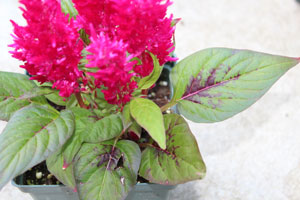
Symptoms of viral diseases are diverse. Symptoms of viral infection include: mosaic, patterns, crinkling, cupping/curling, distortion, stunting, and ringspot patterns. These symptoms may resemble abiotic disorders, chemical damage, or even fungal disease. Viruses become systemic within plants; once a plant is infected, all plant parts are infected.
Management options for viral diseases are limited. Exclusion is the first step toward disease management. Suspect plants should be isolated and/or removed until disease confirmation is possible. Although most viruses are specific to only a few types of plants, prompt and complete removal to prevent its potential spread is recommended when a virus is discovered. Currently there is no chemical control for virus diseases.
[return]
Nematodes
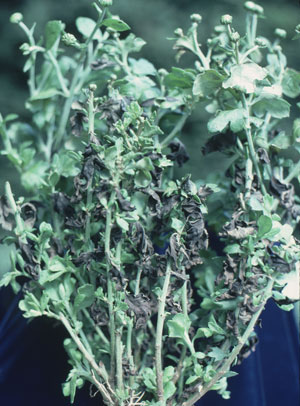
Penn State Department of Plant Pathology & Environmental
Microbiology Archives, Penn State University, Bugwood.org
Nematodes are microscopic roundworms that can infect or infest interiorscapes. Most nematode species feed on roots and cause plant stunting and poor growth because their feeding weakens the root system. Foliar nematodes live within leaf tissues, resulting in brown lesions on older leaves (as in the photo). Nematode diseases tend to be rare on indoor plants.
Management of nematodes should focus on prevention. Exclusion of the pest is the first step toward prevention. There are no fumigants registered for nematode management in interior landscapes. Infested plants should be destroyed before spread occurs.
[return]
1) What is the most critical factor to prevent disease in the indoor landscape?
- Use only tropical plant species.
- Use disease-free plant material.
- Maintain a regular schedule of fungicide application.
- Use only overhead irrigation.
2) The three primary factors of pathogen, host plant, and environment are elements of the
3) The most common source of plant disease is the introduction of infected plant material into the interiorscape.
4) The best samples to send for laboratory analysis and diagnosis are
- several leaves.
- whole plants showing a range of symptoms.
- multiple leaves, stems, and roots showing a range of symptoms.
- a bare root sample with stem attached.
- 1 and 2
- 2 and 3
- 2 and 4
5) When an infection becomes severe, the best solution is to replace the infected plants with healthy ones.
6) Which pathogens are encountered most often in the interiorscape?
7)Target-like leaf spots with concentric rings are most likely indicative of infection by
8) The most common disease caused by water molds is
9) To avoid or correct root rot diseases requires
- proper soil drainage.
- proper irrigation.
- well-managed fertilization.
- good sanitation.
- all of the above
- none of the above
10) As a general rule, the best management practice to prevent the spread of disease in an interior landscape is
website content by R. Bessin website designed by P.M. Dillon copyright © 2019 University of Kentucky Department of Entomology
University of Kentucky College of Agriculture |
S-225 Agricultural Science Center North, Lexington, KY 40546-0091 | 859.257.7450
An Equal Opportunity University |
Last modified
08/27/2019
